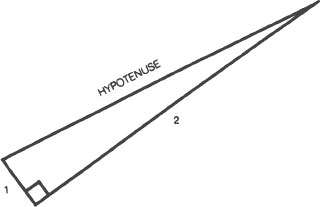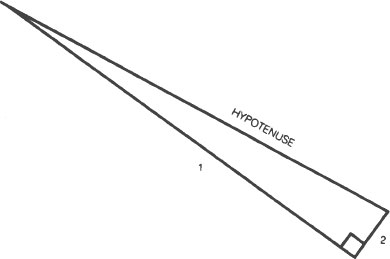The Dancing Wu Li Masters (22 page)
Read The Dancing Wu Li Masters Online
Authors: Gary Zukav


or the other way round,

or anything in between.

If we substitute “space” for one of the legs of a right triangle, “time” for the other leg, and “space-time interval” for the hypotenuse, we have a relationship which is conceptually analogous to the relationship between space, time, and the space-time interval described in the special theory of relativity.
*
The space-time interval between two events is an absolute. It never varies. It can appear differently to observers in different states of motion, but it is, itself, invariant. The special theory of relativity shows how observers in different frames of reference can observe the same two events and calculate the space-time interval between them. The answer that all of the observers get will be the same.
One observer may be in a state of motion such that for him there
is a time and a distance involved between the two events, and another observer may be in a state of motion such that his measuring devices indicate a different distance and a different time between the events, but the space-time interval between the two events does not vary. For example, the space-time interval, the absolute separation, between two exploding stars is the same whether it is viewed from a slow-moving frame of reference, like a planet, or from a fast-moving frame of reference, like a speeding rocket.
*

Let us return to our experiment with the moving glass room. Although we inside the room saw the light strike the rearward and forward walls simultaneously, the outside observer saw the light strike the rearward wall before it reached the forward wall. Nevertheless, by using a Pythagorean-like equation, into which we and the outside observer feed our time and distance measurements, we both get the same space-time interval between the events.
Actually, this Pythagorean-like relationship was the discovery of
Einstein’s mathematics teacher, Hermann Minkowski, who was inspired by his most famous student’s special theory of relativity. In 1908 Minkowski announced his vision this way:
Henceforth space by itself, and time by itself, are doomed to fade away into mere shadows, and only a kind of union of the two will preserve an independent reality.
8
Minkowski’s mathematical explorations of space and time were both revolutionary and fascinating. Out of them came a simple diagram of space-time showing the mathematical relationship of the past, present, and the future. Of the wealth of information contained in this diagram, the most striking is that all of the past and all of the future, for each individual, meet and forever meet, at one single point,
now
. Furthermore, the
now
of each individual is specifically located and will never be found in any other place than
here
(wherever the observer is at).
Sixty-three years before Ram Dass’s great book,
Be Here Now
, established the watchwords of the awareness movement, Hermann Minkowski proved that, in physical reality, no choice exists in the matter (pun?). Unfortunately for physicists, the realization is not always the experience. Nonetheless, after two thousand years of use in the East, being here now, the beginning step in meditation, received the validation of western science via Minkowski’s rigorous mathematical confirmation of it, inspired by the special theory of relativity.
The last and the most famous aspect of the special theory of relativity is the revelation that mass is a form of energy, and that energy has mass. In Einstein’s words, “Energy has mass and mass represents energy.”
9
Although this sounds shocking in one sense, in the sense that we have believed ever so long that matter, stuff, is different from energy just as the body is different from the mind (another form of the same theory), in another sense, it sounds surprisingly natural. The matter-energy dichotomy goes back at least as far as the Old Testament. Gen
esis portrays man as a sort of ceramic creation. God scoops up a handful of clay (matter) and breathes life (energy) into it. The Old Testament is a product of the western world (or the other way round). Physics also is a product of the western world.
In the East, however, there never has been much philosophical or religious (only in the West are these two separate) confusion about matter and energy. The world of matter is a relative world, and an illusory one: illusory not in the sense that it does not exist, but illusory in the sense that we do not see it as it really is. The way it really is cannot be communicated verbally, but in the attempt to talk around it, eastern literature speaks repeatedly of dancing energy and transient, impermanent forms. This is strikingly similar to the picture of physical reality emerging from high-energy particle physics. Buddhist literature does not speak of learning new things about reality, but about removing veils of ignorance that stand between us and what we already
are
. Perhaps this accounts for the fact that the preposterous claim that mass is only a form of energy is unexpectedly palatable.
The formula which expresses the relationship of mass to energy is the most famous formula in the world: E = mc
2
. The energy contained in a piece of matter is equal to the mass of the matter multiplied by an extraordinarily large number, the speed of light squared. This means that even the tiniest, the very tiniest particle of matter has within it a tremendous amount of concentrated energy.
Although Einstein didn’t know it at the time, he discovered the secret of stellar energy. Stars continuously convert matter into energy. It is because of the very large ratio of energy released to matter consumed that stars can continue to burn through countless millennia.
At the center of a star, hydrogen atoms, the primordial “stuff” of the physical world, are squeezed together so tightly by the enormous gravitational force of the star’s dense mass that they fuse together, making a new element, helium. Every four hydrogen atoms become one helium atom. However, the mass of one helium atom is not the same as the mass of four hydrogen atoms. It is slightly less. This small difference in mass is released as radiant energy—heat and light. The process of fusing lighter elements into heavier elements is called, of
course, fusion. The fusion of hydrogen into helium causes a hydrogen explosion. In other words, a (young) burning star literally is one huge, continuously exploding hydrogen bomb.
*
The formula E = mc
2
also resulted in the atomic bomb. Atomic bombs and atomic reactors obtain energy from mass by the process of fission, which is the opposite of fusion. Instead of fusing smaller atoms into larger ones, the process of fission splits atoms of uranium, which are quite large, into atoms which are smaller.
This is done by firing a subatomic particle, a neutron, at an atom of uranium. When the neutron hits the uranium atom, it splits it into lighter atoms, but the mass of these smaller atoms together is less than the mass of the parent atom of uranium. The difference in mass explodes into energy. This process also produces additional neutrons which fly off to strike other uranium atoms, creating more fissions, more light atoms, more energy, and more neutrons. The whole phenomenon is called a chain reaction. An atomic bomb is an uncontrolled chain reaction.
A hydrogen (fusion) bomb is produced by detonating an atomic (fission) bomb in the midst of hydrogen. The heat from the atomic explosion (in place of the heat of friction caused by gravity) fuses hydrogen atoms into helium atoms and releases heat in the process which fuses together more hydrogen atoms, releasing more heat, and so on. There is no limit to the size of a potential hydrogen bomb, and it is constructed from the most plentiful element in the universe.
For better or worse, a major revelation of the special theory of relativity is that mass and energy are different forms of the same thing. Like space and time, they are not separate entities. There is no qualitative difference between mass and energy; there is only mass-energy. Mathematically, this discovery meant that the two conservation laws of mass and energy could be replaced by a single conservation law of mass-energy.
A conservation law is a simple statement that a quantity of something, whatever it may be, never changes no matter what happens. For example, suppose that there were a conservation law governing the number of guests at a party. If such a thing were true, we would notice that every time a new guest arrived at the party, some other guest would leave. Similarly, every time a guest at the party left, another one would arrive. The rate of guest turnover at the party might be great or small, and the guests might arrive and depart singly or in groups, but in all circumstances the number of guests at the party would remain the same.
The conservation law concerning energy says that the total amount of energy in the universe always has been and always will be the same. We can convert energy from one form to another (like mechanical energy to thermal energy via friction), but the total amount of energy in the universe does not change. Similarly, the law of the conservation of matter says that the total amount of matter in the universe always has been and always will be the same. We can convert matter from one form to another (like ice to water or water to steam), but the total amount of matter in the universe does not change.
When the special theory of relativity combined mass and energy into mass-energy, it also combined the law of the conservation of mass and the law of the conservation of energy into the law of the conservation of mass-energy. The law of the conservation of mass-energy says that the total amount of mass-energy in the universe always has been and always will be the same. Mass may be converted into energy and energy may be converted into mass, but the total amount of mass-energy in the universe does not change.
The sun, the stars, even wood burning in the fireplace, are examples of mass being converted into energy. Physicists who study subatomic particles are so familiar with the concept of exchanging mass for energy and energy for mass that they routinely designate the mass size of particles in terms of their energy content.
In all, there are roughly twelve conservation laws. These simple laws are becoming more and more important, especially in high-
energy particle physics, because they are derived from what physicists now believe to be the ultimate principles (latest dance) governing the physical world. These are the laws of symmetry.
